The Romantic Manifesto: A Philosophy of Literature Read online
Page 2
For instance, consider two statues of man: one as a Greek god, the other as a deformed medieval monstrosity. Both are metaphysical estimates of man; both are projections of the artist’s view of man’s nature; both are concretized representations of the philosophy of their respective cultures.
Art is a concretization of metaphysics. Art brings man’s concepts to the perceptual level of his consciousness and allows him to grasp them directly, as if they were percepts.
This is the psycho-epistemological function of art and the reason of its importance in man’s life (and the crux of the Objectivist esthetics).
Just as language converts abstractions into the psycho-epistemological equivalent of concretes, into a manageable number of specific units—so art converts man’s metaphysical abstractions into the equivalent of concretes, into specific entities open to man’s direct perception. The claim that “art is a universal language” is not an empty metaphor, it is literally true—in the sense of the psycho-epistemological function performed by art.
Observe that in mankind’s history, art began as an adjunct (and, often, a monopoly) of religion. Religion was the primitive form of philosophy: it provided man with a comprehensive view of existence. Observe that the art of those primitive cultures was a concretization of their religion’s metaphysical and ethical abstractions.
The best illustration of the psycho-epistemological process involved in art can be given by one aspect of one particular art: by characterization in literature. Human character—with all of its innumerable potentialities, virtues, vices, inconsistencies, contradictions—is so complex that man is his own most bewildering enigma. It is very difficult to isolate and integrate human traits even into purely cognitive abstractions and to bear them all in mind when seeking to understand the men one meets.
Now consider the figure of Sinclair Lewis’s Babbitt. He is the concretization of an abstraction that covers an incalculable sum of observations and evaluations of an incalculable number of characteristics possessed by an incalculable number of men of a certain type. Lewis has isolated their essential traits and has integrated them into the concrete form of a single character—and when you say of someone, “He’s a Babbitt,” your appraisal includes, in a single judgment, the enormous total conveyed by that figure.
When we come to normative abstractions—to the task of defining moral principles and projecting what man ought to be—the psycho-epistemological process required is still harder. The task demands years of study—and the results are almost impossible to communicate without the assistance of art. An exhaustive philosophical treatise defining moral values, with a long list of virtues to be practiced, will not do it; it will not convey what an ideal man would be like and how he would act: no mind can deal with so immense a sum of abstractions. When I say “deal with” I mean retranslate all the abstractions into the perceptual concretes for which they stand—i.e., reconnect them to reality—and hold it all in the focus of one’s conscious awareness. There is no way to integrate such a sum without projecting an actual human figure—an integrated concretization that illuminates the theory and makes it intelligible.
Hence the sterile, uninspiring futility of a great many theoretical discussions of ethics, and the resentment which many people feel toward such discussions: moral principles remain in their minds as floating abstractions, offering them a goal they cannot grasp and demanding that they reshape their souls in its image, thus leaving them with a burden of undefinable moral guilt. Art is the indispensable medium for the communication of a moral ideal.
Observe that every religion has a mythology—a dramatized concretization of its moral code embodied in the figures of men who are its ultimate product. (The fact that some of these figures are more convincing than others depends on the comparative rationality or irrationality of the moral theory they exemplify.)
This does not mean that art is a substitute for philosophical thought: without a conceptual theory of ethics, an artist would not be able successfully to concretize an image of the ideal. But without the assistance of art, ethics remains in the position of theoretical engineering: art is the model-builder.
Many readers of The Fountainhead have told me that the character of Howard Roark helped them to make a decision when they faced a moral dilemma. They asked themselves: “What would Roark do in this situation?”—and, faster than their mind could identify the proper application of all the complex principles involved, the image of Roark gave them the answer. They sensed, almost instantly, what he would or would not do—and this helped them to isolate and to identify the reasons, the moral principles that would have guided him. Such is the psycho-epistemological function of a personified (concretized) human ideal.
It is important to stress, however, that even though moral values are inextricably involved in art, they are involved only as a consequence, not as a causal determinant: the primary focus of art is metaphysical, not ethical. Art is not the “handmaiden” of morality, its basic purpose is not to educate, to reform or to advocate anything. The concretization of a moral ideal is not a textbook on how to become one. The basic purpose of art is not to teach, but to show—to hold up to man a concretized image of his nature and his place in the universe.
Any metaphysical issue will necessarily have an enormous influence on man’s conduct and, therefore, on his ethics; and, since every art work has a theme, it will necessarily convey some conclusion, some “message,” to its audience. But that influence and that “message” are only secondary consequences. Art is not the means to any didactic end. This is the difference between a work of art and a morality play or a propaganda poster. The greater a work of art, the more profoundly universal its theme. Art is not the means of literal transcription. This is the difference between a work of art and a news story or a photograph.
The place of ethics in any given work of art depends on the metaphysical views of the artist. If, consciously or subconsciously, an artist holds the premise that man possesses the power of volition, it will lead his work to a value orientation (to Romanticism). If he holds the premise that man’s fate is determined by forces beyond his control, it will lead his work to an anti-value orientation (to Naturalism). The philosophical and esthetic contradictions of determinism are irrelevant in this context, just as the truth or falsehood of an artist’s metaphysical views is irrelevant to the nature of art as such. An art work may project the values man is to seek and hold up to him the concretized vision of the life he is to achieve. Or it may assert that man’s efforts are futile and hold up to him the concretized vision of defeat and despair as his ultimate fate. In either case, the esthetic means—the psycho-epistemological processes involved—remain the same.
The existential consequences, of course, will differ. Amidst the incalculable number and complexity of choices that confront a man in his day-by-day existence, with the frequently bewildering torrent of events, with the alternation of successes and failures, of joys that seem too rare and suffering that lasts too long—he is often in danger of losing his perspective and the reality of his own convictions. Remember that abstractions as such do not exist: they are merely man’s epistemological method of perceiving that which exists—and that which exists is concrete. To acquire the full, persuasive, irresistible power of reality, man’s metaphysical abstractions have to confront him in the form of concretes—i.e., in the form of art.
Consider the difference it would make if—in his need of philosophical guidance or confirmation or inspiration—man turns to the art of Ancient Greece or to the art of the Middle Ages. Reaching his mind and emotions simultaneously, with the combined impact of abstract thought and of immediate reality, one type of art tells him that disasters are transient, that grandeur, beauty, strength, self-confidence are his proper, natural state. The other tells him that happiness is transient and evil, that he is a distorted, impotent, miserable little sinner, pursued by leering gargoyles, crawling in terror on the brink of an eternal hell.
The consequences of both experi
ences are obvious—and history is their practical demonstration. It is not art alone that was responsible for the greatness or the horror of those two eras, but art as the voice of philosophy—of the particular philosophy that dominated those cultures.
As to the role of emotions in art and the subconscious mechanism that serves as the integrating factor both in artistic creation and in man’s response to art, they involve a psychological phenomenon which we call a sense of life. A sense of life is a pre-conceptual equivalent of metaphysics, an emotional, subconsciously integrated appraisal of man and of existence. But this is a different, though corollary, subject (which I discuss in Chapters 2 and 3). The present subject is only the psycho-epistemological role of art.
A question raised at the start of this discussion should now be clear. The reason why art has such a profoundly personal significance for men is that art confirms or denies the efficacy of a man’s consciousness, according to whether an art work supports or negates his own fundamental view of reality.
Such is the meaning and the power of a medium which, today, is predominantly in the hands of practitioners who boastfully offer, as their credentials, the fact that they do not know what they are doing.
Let us take them at their word: they don’t. We do.
(April 1965)
2. Philosophy and Sense of Life
SINCE religion is a primitive form of philosophy—an attempt to offer a comprehensive view of reality—many of its myths are distorted, dramatized allegories based on some element of truth, some actual, if profoundly elusive, aspect of man’s existence. One of such allegories, which men find particularly terrifying, is the myth of a supernatural recorder from whom nothing can be hidden, who lists all of a man’s deeds—the good and the evil, the noble and the vile—and who confronts a man with that record on judgment day.
That myth is true, not existentially, but psychologically. The merciless recorder is the integrating mechanism of a man’s subconscious; the record is his sense of life.
A sense of life is a pre-conceptual equivalent of metaphysics, an emotional, subconsciously integrated appraisal of man and of existence. It sets the nature of a man’s emotional responses and the essence of his character.
Long before he is old enough to grasp such a concept as metaphysics, man makes choices, forms value-judgments, experiences emotions and acquires a certain implicit view of life. Every choice and value-judgment implies some estimate of himself and of the world around him—most particularly, of his capacity to deal with the world. He may draw conscious conclusions, which may be true or false; or he may remain mentally passive and merely react to events (i.e., merely feel). Whatever the case may be, his subconscious mechanism sums up his psychological activities, integrating his conclusions, reactions or evasions into an emotional sum that establishes a habitual pattern and becomes his automatic response to the world around him. What began as a series of single, discrete conclusions (or evasions) about his own particular problems, becomes a generalized feeling about existence, an implicit metaphysics with the compelling motivational power of a constant, basic emotion—an emotion which is part of all his other emotions and underlies all his experiences. This is a sense of life.
To the extent to which a man is mentally active, i.e., motivated by the desire to know, to understand, his mind works as the programmer of his emotional computer—and his sense of life develops into a bright counterpart of a rational philosophy. To the extent to which a man evades, the programming of his emotional computer is done by chance influences; by random impressions, associations, imitations, by undigested snatches of environmental bromides, by cultural osmosis. If evasion or lethargy is a man’s predominant method of mental functioning, the result is a sense of life dominated by fear—a soul like a shapeless piece of clay stamped by footprints going in all directions. (In later years, such a man cries that he has lost his sense of identity; the fact is that he never acquired it.)
Man, by his nature, cannot refrain from generalizing; he cannot live moment by moment, without context, without past or future; he cannot eliminate his integrating capacity, i.e., his conceptual capacity, and confine his consciousness to an animal’s perceptual range. Just as an animal’s consciousness cannot be stretched to deal with abstractions, so man’s consciousness cannot be shrunk to deal with nothing but immediate concretes. The enormously powerful integrating mechanism of man’s consciousness is there at birth; his only choice is to drive it or to be driven by it. Since an act of volition—a process of thought—is required to use that mechanism for a cognitive purpose, man can evade that effort. But if he evades, chance takes over: the mechanism functions on its own, like a machine without a driver; it goes on integrating, but integrating blindly, incongruously, at random—not as an instrument of cognition, but as an instrument of distortion, delusion and nightmare terror, bent on wrecking its defaulting processor’s consciousness.
A sense of life is formed by a process of emotional generalization which may be described as a subconscious counterpart of a process of abstraction, since it is a method of classifying and integrating. But it is a process of emotional abstraction: it consists of classifying things according to the emotions they invoke—i.e., of tying together, by association or connotation, all those things which have the power to make an individual experience the same (or a similar) emotion. For instance: a new neighborhood, a discovery, adventure, struggle, triumph—or: the folks next door, a memorized recitation, a family picnic, a known routine, comfort. On a more adult level: a heroic man, the skyline of New York, a sunlit landscape, pure colors, ecstatic music—or: a humble man, an old village, a foggy landscape, muddy colors, folk music.
Which particular emotions will be invoked by the things in these examples, as their respective common denominators, depends on which set of things fits an individual’s view of himself. For a man of self-esteem, the emotion uniting the things in the first part of these examples is admiration, exaltation, a sense of challenge; the emotion uniting the things in the second part is disgust or boredom. For a man who lacks self-esteem, the emotion uniting the things in the first part of these examples is fear, guilt, resentment; the emotion uniting the things in the second part is relief from fear, reassurance, the undemanding safety of passivity.
Even though such emotional abstractions grow into a metaphysical view of man, their origin lies in an individual’s view of himself and of his own existence. The sub-verbal, subconscious criterion of selection that forms his emotional abstractions is: “That which is important to me” or: “The kind of universe which is right for me, in which I would feel at home.” It is obvious what immense psychological consequences will follow, depending on whether a man’s subconscious metaphysics is consonant with the facts of reality or contradicts them.
The key concept, in the formation of a sense of life, is the term “important.” It is a concept that belongs to the realm of values, since it implies an answer to the question: Important—to whom? Yet its meaning is different from that of moral values. “Important” does not necessarily mean “good.” It means “a quality, character or standing such as to entitle to attention or consideration” (The American College Dictionary). What, in a fundamental sense, is entitled to one’s attention or consideration? Reality.
“Important”—in its essential meaning, as distinguished from its more limited and superficial uses—is a metaphysical term. It pertains to that aspect of metaphysics which serves as a bridge between metaphysics and ethics: to a fundamental view of man’s nature. That view involves the answers to such questions as whether the universe is knowable or not, whether man has the power of choice or not, whether he can achieve his goals in life or not. The answers to such questions are “metaphysical value-judgments,” since they form the base of ethics.
It is only those values which he regards or grows to regard as “important,” those which represent his implicit view of reality, that remain in a man’s subconscious and form his sense of life.
“It is importa
nt to understand things”—“It is important to obey my parents”—“It is important to act on my own”—“It is important to please other people”—“It is important to fight for what I want”—“It is important not to make enemies”—“My life is important”—“Who am I to stick my neck out?” Man is a being of self-made soul—and it is of such conclusions that the stuff of his soul is made. (By “soul” I mean “consciousness.”)
The integrated sum of a man’s basic values is his sense of life.
A sense of life represents a man’s early value-integrations, which remain in a fluid, plastic, easily amendable state, while he gathers knowledge to reach full conceptual control and thus to drive his inner mechanism. A full conceptual control means a consciously directed process of cognitive integration, which means: a conscious philosophy of life.
By the time he reaches adolescence, a man’s knowledge is sufficient to deal with broad fundamentals; this is the period when he becomes aware of the need to translate his incoherent sense of life into conscious terms. This is the period when he gropes for such things as the meaning of life, for principles, ideals, values and, desperately, for self-assertion. And—since nothing is done, in our anti-rational culture, to assist a young mind in this crucial transition, and everything possible is done to hamper, cripple, stultify it—the result is the frantic, hysterical irrationality of most adolescents, particularly today. Theirs is the agony of the unborn—of minds going through a process of atrophy at the time set by nature for their growth.

 Anthem
Anthem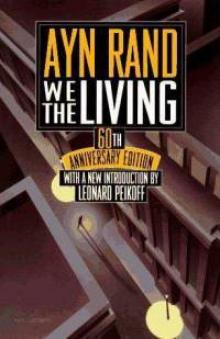 We the Living
We the Living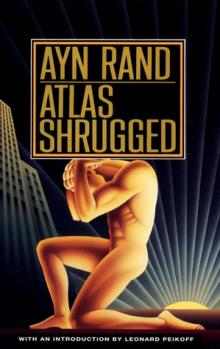 Atlas Shrugged
Atlas Shrugged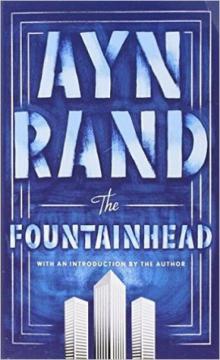 The Fountainhead
The Fountainhead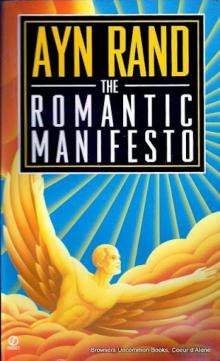 The Romantic Manifesto: A Philosophy of Literature
The Romantic Manifesto: A Philosophy of Literature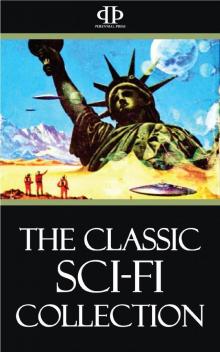 The Classic Sci-Fi Collection
The Classic Sci-Fi Collection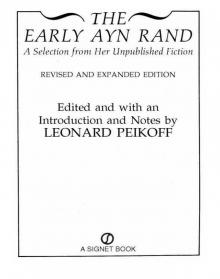 The Early Ayn Rand
The Early Ayn Rand